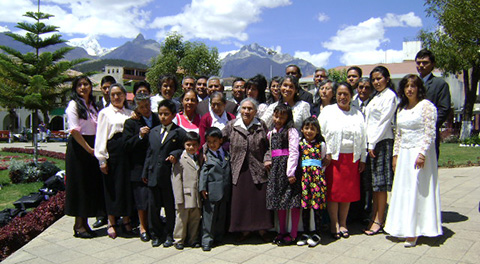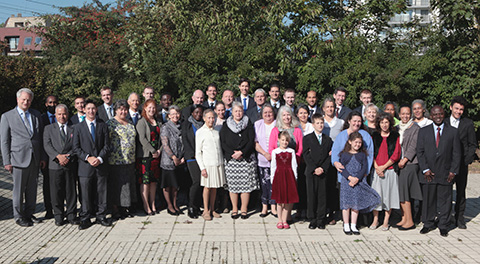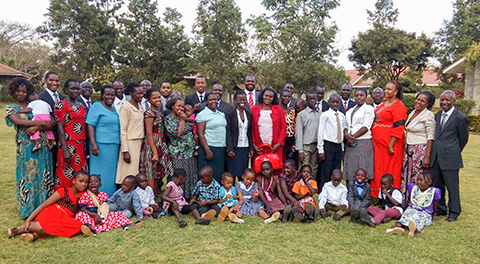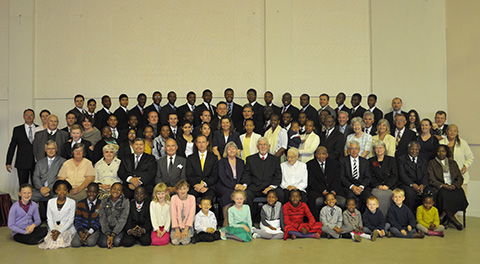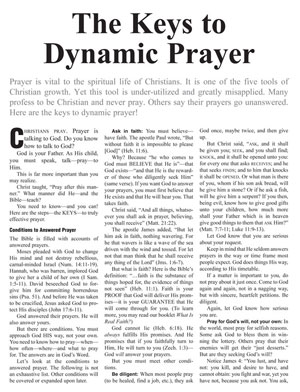Do you ever struggle to know what to pray? Have you ever gotten up from a prayer and realized you forgot to ask for something? Have you started a prayer list, only to let it languish after a short time? Do you currently keep a prayer list but feel it could be better?
If you answered yes to any of these questions, do not worry: You are not alone.
Prayer is one of the five tools of Christian growth, alongside Bible study, meditation, fasting and exercising God’s Spirit. Each tool requires time and effort to maximize its effectiveness, and prayer is no different.
Our article “The Keys to Dynamic Prayer” lays out how to pray using the model prayer given in Matthew 6 and Luke 11 as a format. Those details are beyond the scope of this article. Here, we will explore how to expand and refine your prayer list into a personalized tool, enhancing the efficiency and effectiveness of your petitions to God.
Why Have a Prayer List?
Each tool of Christian growth benefits from additional helper tools. For example, Bible study can involve apps, concordances and dictionaries—and meditation may benefit from using a tried-and-true location or activity to help you think deeply on a matter.
A prayer list is similar. This proven method has been used by many to consistently organize their prayers and ensure they do not forget to cover important topics. It also can show God that we care about the quality of our prayers—we put thought into what we say to Him.
Of course, the Holy Spirit does “make intercession for us with groanings which cannot be uttered,” but this verse primarily applies to when “we know not what we should pray for as we ought” (Rom. 8:26). For the things we do know to pray for, a prayer list helps a lot.
Prayer lists come in many shapes and sizes, and each person’s list is unique. Any prayer list you use is there to help you talk to God, not anyone else. There is no right or wrong style, method or structure.
There are still some helpful guidelines to consider. Your system must be easy to use if you hope to continue with it. Many a prayer list has been cast aside because it is more difficult than helpful. You can avoid under- or over-engineering your system by thoughtfully designing it to capture, organize and maintain prayer topics and requests in a way that makes sense to you.
Whether your current system is thoroughly thought-out, a straightforward list or nothing at all, now is a great time to review how you pray. Even if you like your current list, there is always room to improve or try something new.
How each of us approaches prayer will differ from others. Of course, there is overlap, but prayer involves your personal relationship with God. This will be reflected in a prayer list. Some of us will prefer highly structured systems, while others prefer systems that are free-flowing.
Regardless of your style, it is helpful to consider how you will add a new item and incorporate it into your prayers. When you hear or read about a prayer request for a person in the Announcement Bulletin or think of something personal to you, such as success with a project at work, how do you ensure that it is top of mind when you come before your Creator?
This is where a prayer list system can help. It can ensure you capture a need, organize it into your list, and use it when you pray. Depending on the item, you may eventually remove the request.
Getting Started
If this all sounds like too much, do not worry. Start where you are. If you do not have a list, think about how you currently pray and what it would take to help you capture and organize ideas into a system that reflects that. If you do have a list, think about how much your current processes and tools help you and where they could be lacking.
To capture and organize your prayer ideas, it is helpful to pick a tool, whether a physical notebook, a digital notebook like OneNote or an app like Trello. Find something simple that works for you.
Some of our best prayer ideas can come when we are not expecting: driving, cooking a meal or even in the middle of a prayer! Others may come during conversation or meditation. Pick a tool—or tools—that allows you to easily capture spur-of-the-moment ideas before you forget them.
For example, you could make voice memos on your phone, write in a small notebook or keep index cards in your pocket or purse. Maybe you use one method at your job but a different one at home. You can use nearly anything to capture in-the-moment thoughts.
If you are unsure what to use, try several different methods. Even if the first one seems to work, try another one or two to ensure you know what is most effective and why. You will eventually find the one that is best for you.
Once you have captured some ideas, it is time to organize them to make your prayers easier. Here, you can get creative but not too creative. It should be something easy to use and easy to maintain. If it is not easy to use, you will stop using it. If it is not easy to maintain, you will stop updating it and it will no longer benefit you.
A good rule of thumb when choosing how to organize your prayer list is this: The simplest thing that works. That means starting with something simple and adapting it as you use it.
There are many formats your prayer list can take. Perhaps a single handwritten page will work. An easy place to start is the back of your sermon notebook. If you turn your notebook over during the announcements, the last page becomes the first page where you can record people’s names and prayer requests. You could even include the date you added them to your list.
If you capture prayer items on notecards, you could arrange the cards in the order you use them. To-do lists, a simple text file, a spreadsheet or a specific prayer list app could also work well.
For those of us who prefer a more structured system, you could use a dedicated notebook or a computer app that allows you to create multiple pages to fill in. The model prayer in Matthew 6:9-13 and Luke 11:1-4 gives you a great starting layout. Within each of these areas lies much room for expansion.
Consider just the phrase, “Give us this day our daily bread.” There is so much that fits in this subject. You may want to break it down further into areas like family, career, health, spiritual growth or any other category you come up with.
It may also be helpful to categorize your system by time frames, such as near-term requests for things happening soon, medium-term requests with a date in the future, and long-term requests for lifelong goals and dreams. Maybe you want a particular focus for each day of the week, such as world events on Sunday, the first and second commissions on Friday, family on Tuesday, etc.
Modifying Your System
Many of us could go a lifetime with the system we originally design and have strong prayer lives for it. However, you may find that you want to change how you pray or you feel your system could be better.
Maybe you have been using a single sheet of paper and want to try using a notebook with different sections for different categories. Perhaps you thought you would like having many categories, but you want to return to something simpler.
Whatever you decide, remember that your prayer list is up to you.
Consider discussing your chosen system and share ideas with other brethren. To paraphrase Proverbs 15:22, “In the multitude of counselors [our prayer lists] are established.” Discussing your prayer list tools with others can help you find ways to improve.
Yet realize that not everyone includes a prayer list in their routine. Use discretion when deciding whether to discuss this topic with others. Doing so will prevent you from coming across as self-righteous or holier-than-thou when discussing a matter they may consider to be private.
As you modify your list, you will find that every system has strengths and weaknesses. Try one out for days, weeks or months to see how it goes. If it does not fit you or is challenging to use, that is OK! Try something else.
Once you have a system in place, periodically ask yourself three questions to refine it: What works about this? What does not work about this? What can I do better?
Asking these questions weekly as you build your system will help it improve faster. After settling into your system, ask these questions less frequently, perhaps monthly, during the Holy Day seasons or annually during Passover self-examination. Regularly evaluating your prayer life will ensure your communication with God grows as He desires.
Pruning
If we only add to our prayer list, it will eventually include items that no longer need our prayers. Just as trees benefit from occasional trimming, pruning your prayer list is helpful.
When you review your list, feel free to remove anything no longer needed. When God heals someone, provides a sorely needed job or house, provides strength to overcome a personal trial or otherwise answers a request, these items do not need to remain on your list in the same way.
Sometimes, the Announcement Bulletin includes prayer updates following the initial prayer request, giving us information that helps us know whether to keep praying for the issue or to include new information. You could also contact that person or their minister for an update if you are unsure.
If you are praying about world leaders or specific news events impacting God’s Church and Work (I Tim. 2:1-2), those items can come off your list as you see they are no longer relevant.
But you may not always want to completely remove answered prayers. Instead, you could move them to a separate “answered prayers” list, along with details on how each was answered. This list will build up and give you great material for praising God and bolstering your faith.
Using Your System
Once you have designed and honed your system, you must learn when to use it and when not to. That is right: We should only use a prayer list for some of our prayers!
A prayer list is primarily helpful for longer prayers. Imagine trying to go through your entire list while asking for a blessing on a meal. Any warm food would turn cold, and bellies around the table would loudly grumble before you finished.
An efficient prayer is short enough to get the point across and as long as needed to be effective. Most prayers throughout the day should be focused and specific to the moment. But using your system for your main prayer regularly keeps your mind on what you pray for. When something related comes up during the day, you can be “instant in prayer” (Rom. 12:12) to ask God’s help.
Another caveat about using a prayer list: We do not want our prayers to become dictated or rote. Remembering Christ’s warning against “vain repetition” (Matt. 6:7), the goal is not to write complete paragraphs and read them verbatim when we are on our knees before God.
A prayer list should contain notes for your conversation with God, not a transcript. Rather than complete sentences, use just words or phrases to spark your memory. And feel free to be spontaneous as things come to mind and the Holy Spirit inspires you.
Remember, your prayer list will be different from anyone else’s. Your system will reflect how you pray to God and help you to do this more effectively. It is well worth your effort to build, maintain and use it.
Prayer List Ideas
Where can you get ideas for what to pray about? The weekly Announcement Bulletin in Member Services is a great source of prayer requests already captured. Occasionally, the bulletin also has miracle reports. These are wonderful items to help you praise God and give Him thanks.
The bulletin also includes comments from people whom the Work has impacted. Each person who writes in is a potential God being who needs His mercy. Some may even come into the Church during this age!
Did you know the bulletins from the entire last year are searchable in Member Services? If you missed a prayer request or update, you can easily find it on the Announcement Bulletins page.
We must also pray for our own needs. Paul instructed the Philippians: “Be careful for nothing; but in every thing by prayer and supplication with thanksgiving let your requests be made known unto God” (4:6).
Whether travel, house, job, growth, car or spouse, it goes on the list or else it gets missed!
But what else? The following is adapted from the expandable prayer list in the article “The Keys to Dynamic Prayer.” You can use it to flesh out the prayer outline Christ gave in Matthew 6. You can pray…
- For The Restored Church of God’s Headquarters staff. God is using a small staff to do a big job: To feed Church members—and to take the gospel of the Kingdom of God to the world.
- For the “Lord of the harvest” (Matt. 9:38) to add more ministers and leaders to His Church and the Work.
- For God’s faithful ministry to grow and develop as new people continue to be called into the truth.
- That God will add more Church members, prospective members, co-workers and donors.
- That God will increase the Work’s income and budget. Ask Him to bless His staff with the wisdom they need to use it.
- For God’s servants to make wise decisions in finding better ways to do the Work.
- That God will direct the planning, writing, editing and publishing of each of His magazines.
- About media. Pray about the ongoing development of rcg.org—that more people will be led to it and our free literature. Pray that God will open other doors so that we can reach a wider audience.
- About other important publications, such as festival brochures, the Announcement Bulletin, the annual Church calendar, etc.
- About persecution. Pray that God will prevent Satan from frustrating the gospel message.
- About festival sites. Pray for a successful and smoothly run Feast of Tabernacles.
- That more people will see where the fullness of God’s truth is being taught.
- About every sermon, Church-led Bible study and sermonette. Pray that God will inspire both the speaking and the listening.
- About socials, picnics and other Church functions.
- That as congregations grow, God’s Church will be able to find halls, at the right size and for the right cost.
- For the widows and the elderly of God’s Church.
- For the Headquarters staff to develop and grow so that they can help more people.
- That God will develop His ministry, and that He will guide it with His zeal, wisdom and understanding.
- About your family. Pray for a happy marriage or help in childrearing.
- That God will give you His understanding.
- For protection—not just for yourself, but for others.
- Ask God to guide you in making the right decisions in your life.
- Pray about your health.
- Ask God for self-control, wisdom, more of His Holy Spirit and peace of mind.
- Ask God to help you develop Christ-like humility.
- If you find it difficult to participate in Church-related activities, ask God for His help. God does not give His people “the spirit of fear; but of power, and of love, and of a sound mind” (II Tim. 1:7).
- Pray about finding employment. Or ask God to help you grow and expand upon your job skills. Ask Him to employ others.
- Pray that God will help you grow in His holy, righteous character and spiritual knowledge (II Pet. 3:18).
- Ask God to help you control and conquer various wrong attitudes, thoughts, pulls, desires and temptations.
Note: Every subject on this list that you can pray for yourself should also be used to pray for others.






